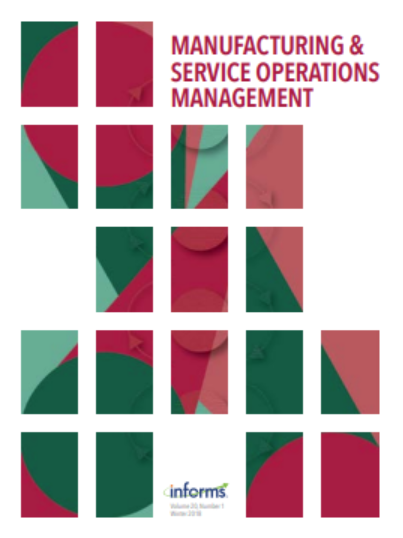面对面还是虚拟?运营管理/研究会议将会是什么样子?
IF 4.8
3区 管理学
Q1 MANAGEMENT
M&som-Manufacturing & Service Operations Management
Pub Date : 2023-10-25
DOI:10.1287/msom.2022.0591
引用次数: 0
摘要
问题定义:我们研究了从面对面会议转变为虚拟会议形式对环境的影响,并确定了这种转变对会议为我们的社会提供的价值的影响。我们扩展了其他领域的工作,对不同会议形式对运营管理/研究界的环境影响和感知价值进行了更全面的比较。方法/结果:我们利用一系列covid -19诱导的自然实验,分别通过生命周期评估和调查技术,精确评估面对面和虚拟格式的环境足迹和社会价值差异。具体而言,我们将重点关注运筹学和管理科学研究所、生产和运营管理学会以及欧洲运营管理协会在2019年至2021年期间以两种形式举行的会议。环境评估显示了巨大的影响减少:对于气候变化,平均而言,从941.9公斤二氧化碳当量的人到1.0公斤的虚拟格式。相反,价值评估强调的是出勤率变化带来的整体感知价值的有害效用损失——在从0到10的范围内,平均从7.9到4.0。在调查会议估值的驱动因素时,虚拟形式显示出一些优点,例如较低的感知成本和灵活性的附加价值。然而,对面对面形式的偏好是明确的,与社交和网络相关的巨大性能差距证明了这一点,这是我们分析中确定的两个最重要的价值驱动因素。管理启示:这些结果突出了虚拟会议和面对面会议之间的内在权衡。为了克服这一问题,我们讨论了四种策略,即我们的社会如何减少其环境足迹并保持其基本目的:(1)减少面对面的影响,(2)改进虚拟设计,(3)混合和分散的形式,以及(4)修改会议模式和社会角色。补充材料:在线附录可在https://doi.org/10.1287/msom.2022.0591上获得。本文章由计算机程序翻译,如有差异,请以英文原文为准。
In-Person or Virtual? What Will Operations Management/Research Conferences Look Like?
Problem definition: We examine the environmental implications of shifting from in-person to virtual conference formats and identify the effects of such a shift on the value conferences provide to our societies. We extend work from other fields to present a more comprehensive comparison of the environmental impact and perceived value of different conference formats for the operations management/research communities. Methodology/results: We leverage a series of COVID-19–induced natural experiments to precisely evaluate the environmental footprint and societal value difference between in-person and virtual formats via life cycle assessment and survey techniques, respectively. Specifically, we focus on Institute for Operations Research and the Management Sciences, Production and Operations Management Society, and European Operations Management Association conferences that were conducted in both formats between 2019 and 2021. The environmental assessment reveals a huge impact reduction: for climate change, on average, from 941.9 kg CO 2eq per person for in-person formats to 1.0 for virtual. The value assessment emphasizes, instead, a detrimental utility loss with the overall perceived value derived from attendance moving—on a scale from 0 to 10—on average, from 7.9 to 4.0. When investigating the drivers of conference valuation, virtual formats show some merits, such as lower perceived costs and the added value of flexibility. The preference for in-person formats is unambiguous though, justified by the large performance gap related to socialization and networking, the two most important value drivers identified by our analysis. Managerial implications: These results highlight an inherent trade-off between virtual and in-person conferences. To overcome it, we discuss four strategies as to how our societies can reduce their environmental footprints and remain true to their essential purpose: (1) reduce in-person impact, (2) improve virtual design, (3) hybrid and decentralized formats, and (4) revise conferencing model and societies’ role. Supplemental Material: The online appendix is available at https://doi.org/10.1287/msom.2022.0591 .
求助全文
通过发布文献求助,成功后即可免费获取论文全文。
去求助
来源期刊

M&som-Manufacturing & Service Operations Management
管理科学-运筹学与管理科学
CiteScore
9.30
自引率
12.70%
发文量
184
审稿时长
12 months
期刊介绍:
M&SOM is the INFORMS journal for operations management. The purpose of the journal is to publish high-impact manuscripts that report relevant research on important problems in operations management (OM). The field of OM is the study of the innovative or traditional processes for the design, procurement, production, delivery, and recovery of goods and services. OM research entails the control, planning, design, and improvement of these processes. This research can be prescriptive, descriptive, or predictive; however, the intent of the research is ultimately to develop some form of enduring knowledge that can lead to more efficient or effective processes for the creation and delivery of goods and services.
M&SOM encourages a variety of methodological approaches to OM research; papers may be theoretical or empirical, analytical or computational, and may be based on a range of established research disciplines. M&SOM encourages contributions in OM across the full spectrum of decision making: strategic, tactical, and operational. Furthermore, the journal supports research that examines pertinent issues at the interfaces between OM and other functional areas.
 求助内容:
求助内容: 应助结果提醒方式:
应助结果提醒方式:


